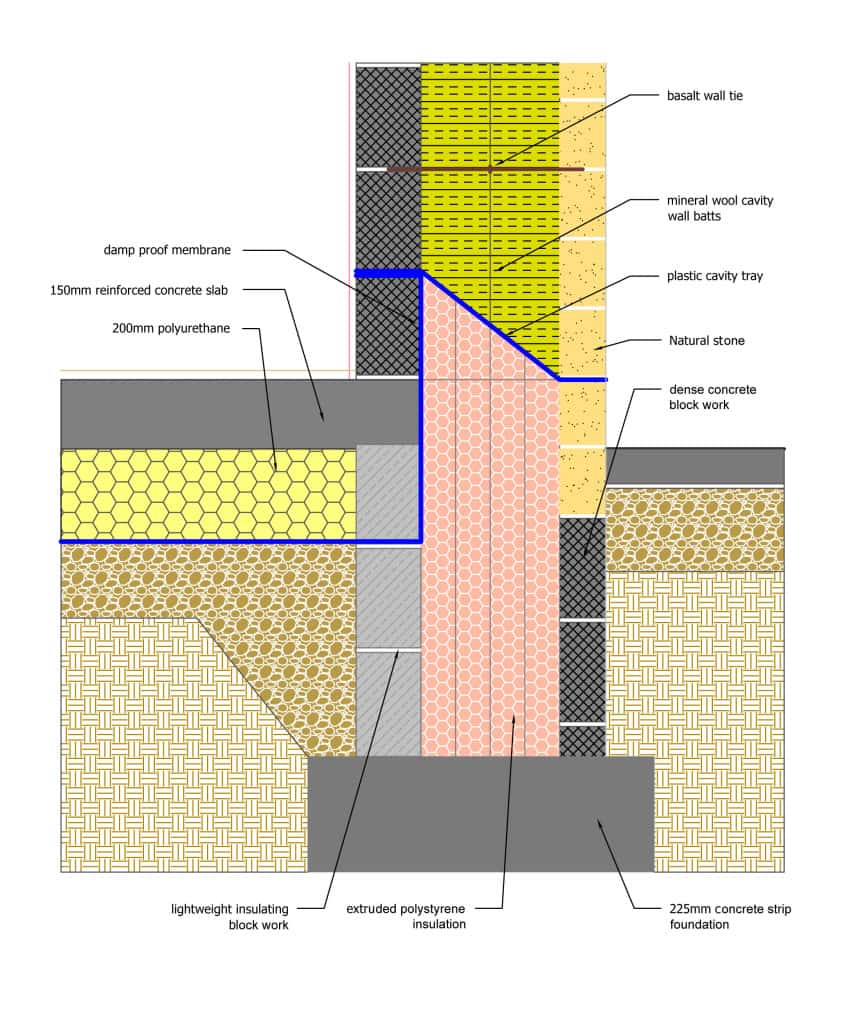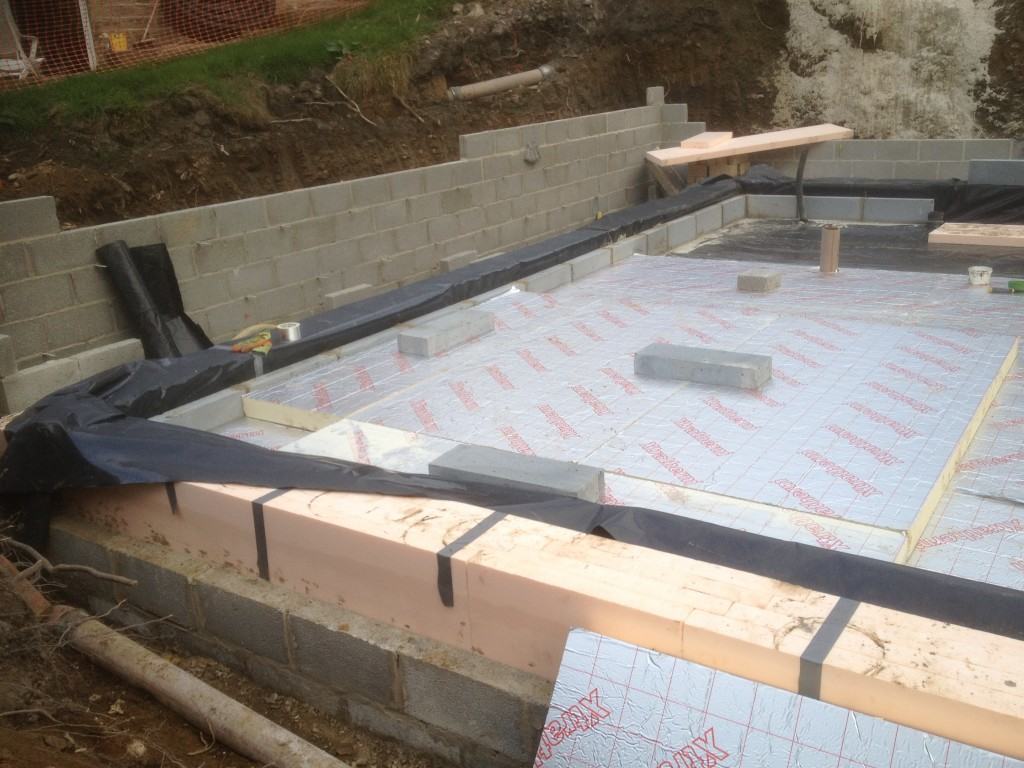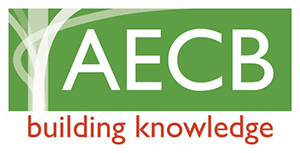The ground floor detailing at the project is very similar to that at the Denby Dale Passivhaus, with a few notable tweaks….
Ground floor detailing – exploring alternative approaches
We did look into using a floating / completely thermal bridge free ground floor/ wall junction. This would have involved building the concrete blockwork inner leaf and ground floor slab off the underfloor insulation and not needing to take the insulation in the cavity down to the foundation strip.
However, the loading on the inner leaf (which additionally carries the intermediate floor and roof) would have been so great that we would have had to upgrade the insulation in terms of compressive strength. This would have a) put the price up and b) lowered the lamda/ U value of the underfloor insulation.
So adding it all together it made sense to go back to the original Denby Dale groundfloor detailing. We did, however, make a few key changes/ improvements to the original detailing:

Golcar Passivhaus ground floor and foundations detailing. Copyright Green Building Store 2014
Damp proof membrane
As at Denby Dale, we’re using the Celcon low thermal conductivity blocks again in the inner leaf below the groundfloor slab to reduce the path of the thermal bridge down to the strip foundations. But this time, learning lessons from Steel Farm (Mark Siddall from LEAP Architecture’s cavity wall Passivhaus project) we have taken the damp proof membrane around the first course of Celcon block below the groundfloor slab, which means it will stay dry and maintain its lamda value. We’ve then dressed the damp proof membrane up within the cavity and back into the inner DPC. At Denby Dale we don’t think it is a real problem, as it was a very dry site, but this is a ‘belt and braces’ approach that Mark Siddall introduced us to.
Polystyrene insulation – change in specification

We have also changed the type of polystyrene we’re using in the cavity, below the cavity tray down to the foundation strip. We have discovered that extruded polystyrene is more water repellent than the expanded polystyrene we used at Denby Dale. So, for the Golcar Passivhaus we’ve decided to use Knauf Polyfoam extruded polystyrene to minimise the risk of moisture affecting the thermal performance of insulation.
Underfloor insulation– change in specification
For the underfloor insulation in the slab itself, we’ve used 200mm polyurethane under the slab because of its better lamda values. (0.022).
The next blog will look at window & door thresholds and positioning within the insulation to minimise thermal bridging..
Bill Butcher, Director, Green Building Store www.greenbuildingstore.co.uk










Can extruded polystyrene insulation be added along inside face of insulating block below floor slab down to foundation strip to minimise thermal bridge at floor insulation and inside leaf interface?
Regards
Paul
Paul,
The simple answer is yes, but our Therm calculations show a ‘thermal bridge free’ junction without. As a general comment, we obviously want to keep costs to the minimum. There is always a danger of over engineering/specifying. Passivhaus is designed around the 15Kw/m2/annum for comfort and economic reasons. There is a diminishing economic return on going below the 15Kw benchmark. The key here is accurate PHPP and Therm calculations which gives the designer confidence not to over engineer.
Is there a natural alternative to polystyrene insulation?
You might try
http://www.plasmor.co.uk/products-services/techniclay-aggregate
or
https://www.geocell-schaumglas.eu/en/
or
https://www.foamglas.com/en-gb …….. expensive.
Bill
What is the reason why the insulation below the slab cannot be extended into the inner leaf to improve the continuity of insulation?
Perhaps something like EPS 300 with its high compressive strength?
The result feels like a hybrid of a raft and a strip foundation?
But it seems so obvious that I’m sure there must be a reason why it hasn’t been done?
Thanks for your time!
Chris
Hi Chris,
Always good to question a detail. The reason is the transferring of the structural load as specified by the Structural Engineer.
The priority in a base detail is to transfer the load to the foundation whilst ensuring the structural waterproofing defends the building, followed by thermal continuity in the design. A structural engineer needs to drive the specification to accommodate all loads, and whilst your idea can be achieved, covering all 3 primary aspects of a base detail is expensive (esp in the context of residential house buildings), and this usually results in a value engineered approach to achieve firstly the load transfer for structural integrity (in this case concrete and blocks), then ensuring full water-tightness, followed by the thermal jacket, which as you is are pointing out is best designed and constructed with continuity to avoid localised cold bridging.
To achieve this (in high spec buildings & subject to the Architects and Engineer spec and Approval), load bearing Foamglas Perinsul HL can be introduced at the base of the wall for the thermal continuity. The only issue with this is cost, which is why a QS is integral to the success of a project (commercial success that is). The technical performance specification drives the cost up, so this sort of detailing is always dependant on the Client’s budget and what is achievable in compliance with the British standards, codes of practise and the warranty providers (such as NHBC / Protec)
I would point out, because the designer of this detail has taken the insulation down to meet the footing below ground, they will not be much thermal transmission from frost etc.
Eric